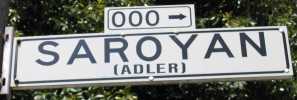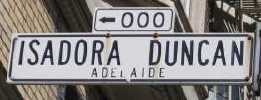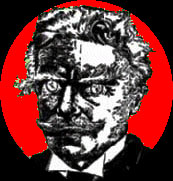
____________________
Ambrose Bierce Alley will be found at Third and Market Streets behind the site of the old San Francisco Examiner, where Bierce was William Randolph Hearst's star columnist and the paper's only writer with a byline.
The narrow backstreet was formerly called Aldrich Alley, named for Mark Aldrich (1801-1874), although why is lost to history. Aldrich, born in New York, was later elected to the Illinois legislature. In 1844, he was tried and acquitted in the murder of Joseph Smith, founder of the Mormon church, a victim of a lynch-mob in Carthage, Illinois. Aldrich followed the Gold Rush to California, but spent his last years in Tucson, Arizona, as postmaster, judge, mayor, and a representative in the territorial legislature.
Most San Franciscans are unaware of Ambrose Bierce Alley, among them the affable proprietor of San Francisco's Argonaut Book Shop at nearby Sutter Street, Robert Haines, Jr. Mr. Haines says he never heard of the alley until recently informed by a visitor to his shop, which is a treasure trove of California lore and letters.
Ambrose Bierce Alley, alas, may have had better days. This rank passageway has a juice bar on one side and a sterile office building on the other. The walls are marred by graffiti, and at the time the photos on this page were taken building construction blocked off half the street.
The idea of naming the alley for Bierce was that of Lawrence Ferlinghetti, owner of San Francisco's esteemed City Lights Bookstore on Columbus Avenue. Mr. Ferlinghetti proposed renaming certain streets, mostly alleys and cul-de-sacs, after famous writers and artists who lived and worked in San Francisco.
Ferlinghetti, sometimes referred to as the father of the Beat writers and a prominent poet in his own right, co-founded the store, which was declared an official historic landmark by the city's Board of Supervisors in 1953. In 1955, Ferlinghetti launched City Lights Publishers, which published Allen Ginsberg's seminal Howl a year later. Ferlinghetti was arrested for publishing an obscene book, which led to a precedent-setting legal decision on the side of the First Amendment, signaling the death-knell for future would-be censors. [Don Swaim's audio interview with Ferlinghetti here]
As most literary buffs know, Bierce vanished in Mexico in 1913, purportedly after trying to join Pancho Villa's rebel army. I couldn't resist including this shot of the Pancho Villa Taqueria, 3071Sixteenth Street, in the Mission District, a taqueria being a modest Mexican restaurant specializing in tacos. The Pancho Villa Taqueria is known for its salsa -- and its grilled vegetable burritos are pretty good too. Bierce left San Francisco for good in 1899 for Washington, D.C., although he paid a final visit to the City by the Bay in 1912. San Francisco is a vibrant and colorful metropolis with a harsh terrain and contentious weather. It has to be a wondrous place to live for the young. It's clear why the youthful Ambrose Bierce made his home there -- and why he chose to leave.
____________________ Sources: Streets of San Francisco by Louis L. Lowenstein, Wilderness Press, Berkley, 1996; Names of 12 San Francisco Streets Changed to Honor Authors and Artists, City Lights Books, San Francisco, 1989; The Letters of Ambrose Bierce edited by Bertha Clark Pope, Gordian Press, New York, 1967. I am also indebted to the Center for California History, San Francisco Library. |














